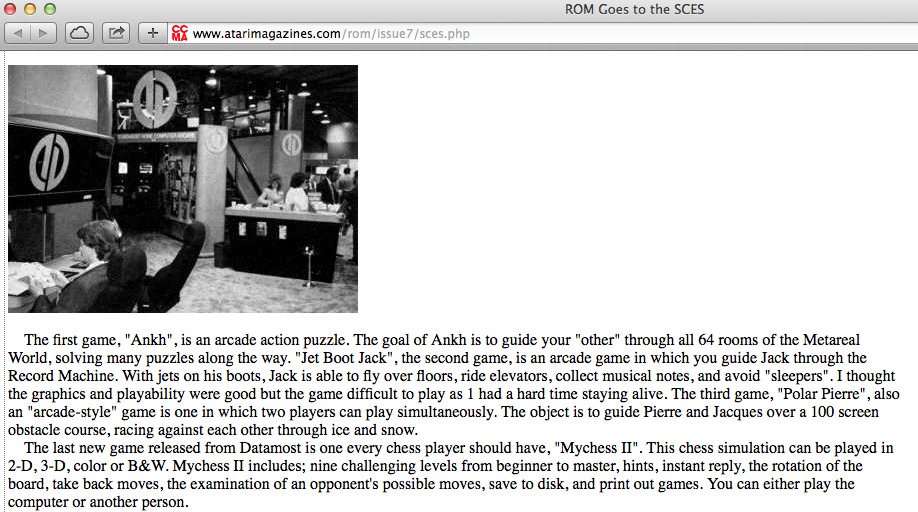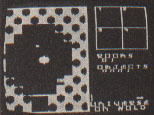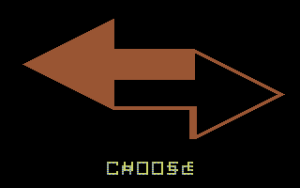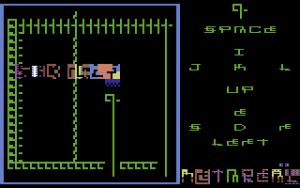Always amusing to come across a reference…
Category Archives: 1984
Summer CES 1984
Datamost was a software company in the 1980s, with roots to a 1970s software company called Programma International. Datamost had a booth at the Summer Consumer Electronics Show, June of 1984. Ankh was shown there.

Antic Magazine, Volume 4, Number 7, November 1985
Antic Magazine, Volume 4, Number 7, November 1985
ANKH
Datamost
19821 Nordhoff Street
Northridge, CA 91324
(818) 703-1202
$19.95, 48K disk
Reviewed by Jack Powell

When I was a child, I bought a puzzle box in Chinatown. It was lacquer-shiny and inlaid with all sorts of colorful, cryptic symbols. And to open it up, you had to find these hidden panels and slide them up, right, down, and in just the right combination before the top slid back.
ANKH from Datamost is a little like that Chinese puzzle box. It’s called an “Adventure in the MetaReal World” but it’s really more of a graphic puzzle than an adventure.
You control a strange little four-color blimp, described in the documentation as your “other.” The object is to explore all 64 rooms in the game. And to do this, you have to solve various puzzles by opening doors and picking up objects. A large part of the challenge is figuring out just what the puzzles are.
There are a few meanies to avoid in some of rooms. You can shoot them, or outrun them. They’re really not that dangerous, the main thing is the puzzle factor.
And you must always watch your Karma. It’s the green line on the right of the screen.
If this doesn’t sound like your usual computer game, you’re right. It’s different. In philosophical tone, it’s a little like Lifespan from the Antic Arcade Catalog. Game play, however is closer to Sir Galahad and the Holy Grail.
The documentation is purposely vague. It really can’t say much without spoiling the game. A flyer was included in the package, however, which takes the player, step by step, through the first few puzzles. Datamost probably added this after their phone started ringing off the hook.
The ambiguity can get pretty frustrating. When the game begins, you’re presented with arrows pointing right and left, and the word “CHOOSE.” Choose “right” and you begin what appears to be the main game. Choose “left” however, and you end up playing around with what seems to be a pointless character-graphics screen. I’ve gone both directions and made it through 54 of the 64 rooms, but I still haven’t figured out what’s going on in the “left” area. It’s mentioned nowhere in the documentation. Perhaps it’s a meditation room.
ANKH is not an action game. There’s plenty of time to sit in one room and think about your next move. Some solutions require coordination, but most require experimentation and abstract reasoning.
If you like puzzles, this is your kind of computer game. I like puzzles.
ankh.dsk
Personal Computer News, Issue 086, 1984-11-10
ANKH
This game is something else but exactly what I’m not sure. Put at its simplest (and this game is anything but simple), Ankh is a series of logic puzzles, some unbelievably tough.
The game environment is described as the ‘Metareal world of Ankh where logic works but doesn’t rule’. The idea is to find your way through 64 connecting rooms, each of which is different and holds a puzzle. Sometimes you can pass through a room’s doorway with no trouble but mostly you need to find a way to open up the exit before you can pass.
Each room must be prodded, poked and probed to yield up its secrets. Solving a room’s puzzle may bring forth a treasure, a tool or (groan) yet a further puzzle. You control a spherical object, your Mindprobe. It can be moved around and fire missiles. You gain power by performing certain actions (gaining access to a new room, for example) and lose it at a rate of knots when you collide with your environment. The game is over when you lose all power – or when you solve it.
At start-up you have the opportunity to experiment on an abstract set-up – a confidence-sapping experience in my case. You may also select the level of perplexity of the puzzles (from mindboggling to mind shattering).
A real headache inducer, Ankh is like nothing you’ve played before. There’s no middle way – you either love it madly or stick it straight under a steam hammer.
Issue: 086
Publication Date: November 10 1984
Subsection: GAMEPLAY
Article Name: Ankh
Author: Bob Chappell
Computer: Commodore 64
Price: £8.95 (Cassette)
Publisher: Beyond
Reviewer: Bob Chappell
Rating: 8/10
Enter
Perhaps the most oddly suitable opening to this blog will be a translation from a Swedish computer magazine in 1984:
When you load up Ankh for the first time, it is mostly a big mystery. After ten minutes in this peculiar world you will probably go back to the game instructions and note once again that it (indeed) is mostly a big mystery. The ones who do not give up right there and then will be stuck in “The Metareal World of Ankh” for many weeks.
The object is to discover and explore 64 rooms using your craft (The Mindprobe). You can shoot or poke at different objects and if you do right, a door to an adjacent room might open. In this type of game a key usually opens a door, a treasure chest gives points etc. but that is not the case in Ankh. There are plenty of objects to pick up, but their function and usage is to be discovered by yourself. What will you do with a pink triangle? Why does a star twinkle when you touch the small green square? It is mostly very abstract but it gets more and more logical the further in the game you get. Most rooms have their very own problem for you to solve and you will constantly find new perplexing items. When (if) you have found all rooms, there are still strange (inexplicable?) phenomena to wonder at. And listen carefully: you will only find the solutions to some problems by means of hearing.
If my description of Ankh seems abstract and incomprehensible, it is not my fault. That is one half of the game’s charm. The other half will fit you like a glove if you like tricky brainteasers.
Many thanks to Fabio Cataldo and Adam Grpsve for this translation.




